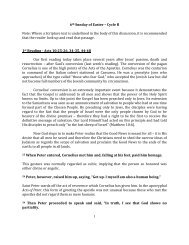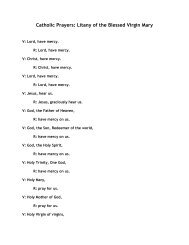The Wedding Feast at Cana - St. Charles Borromeo Catholic Church
The Wedding Feast at Cana - St. Charles Borromeo Catholic Church
The Wedding Feast at Cana - St. Charles Borromeo Catholic Church
You also want an ePaper? Increase the reach of your titles
YUMPU automatically turns print PDFs into web optimized ePapers that Google loves.
<strong>The</strong> <strong>Wedding</strong> <strong>Feast</strong> <strong>at</strong> <strong>Cana</strong> (Jn 2:1-11)<br />
A Reflection<br />
John’s ostensibly simple narr<strong>at</strong>ive of the wedding feast <strong>at</strong> <strong>Cana</strong> explodes in layers of<br />
meaning when it is examined in faith. This reflection proposes to offer some insights<br />
th<strong>at</strong> may deepen your understanding and stimul<strong>at</strong>e your discoveries in this rich passage.<br />
It is no accident th<strong>at</strong> John begins his Gospel with the identical words th<strong>at</strong> open the<br />
Bible: “In the beginning” (Gen 1:1). In the first chapter of Genesis the emphasis is on<br />
the ascending order of cre<strong>at</strong>ion culmin<strong>at</strong>ing in form<strong>at</strong>ion of Adam and Eve on the sixth<br />
day. In the recapitul<strong>at</strong>ion in second chapter of Genesis the emphasis shifts to the<br />
covenant God established with his favorite cre<strong>at</strong>ures to whom God gave dominion over<br />
the earth. This covenantal rel<strong>at</strong>ionship is depicted in the Bible as a family bond or a<br />
marriage.<br />
In the first chapter of John’s Gospel the evangelist lays out a literary new cre<strong>at</strong>ion week.<br />
On the first day the Word who is God is depicted as coming to make a “new cre<strong>at</strong>ion” (2<br />
Cor 5:17). He is both “life” and the “light of men” paralleling the first day of cre<strong>at</strong>ion in<br />
Genesis when God said: “Let there be light” (Jn 1:4; Gen 1:3). <strong>The</strong> first three days of<br />
John’s literary cre<strong>at</strong>ion week are laid out as follows:<br />
First Day: Jn 1:1-34<br />
Second Day: Jn 1:29-34 beginning with the words: “<strong>The</strong> next day”<br />
Third Day: Jn 1:35-42 beginning with the words: “<strong>The</strong> next day”<br />
Fourth Day: Jn 1:43-51 beginning with the words: “<strong>The</strong> next day”<br />
Seventh Day: Jn 2:1-11 wedding <strong>at</strong> <strong>Cana</strong><br />
Chapter two introduces the marriage <strong>at</strong> <strong>Cana</strong> with the words: “On the third day” (Jn<br />
2:1). John uses this cryptic technique to highlight th<strong>at</strong> this wedding also takes place on<br />
the seventh day. In this way he captures the resurrection motif with the number three<br />
and the covenantal/marriage motif of the number seven.<br />
In the <strong>Cana</strong> narr<strong>at</strong>ive a problem arose <strong>at</strong> the wedding feast. <strong>The</strong> wine had run out. This<br />
was a serious breach in the marriage etiquette, as it was the bridegroom’s oblig<strong>at</strong>ion to<br />
supply the wine. Mary notices the crisis and brings it to Jesus’ <strong>at</strong>tention. He gives a<br />
mysterious reply: “O woman, wh<strong>at</strong> have you to do with me? My hour has not yet come”<br />
(Jn 2:4). Transl<strong>at</strong>ors and exegetes grapple with mixed success to achieve <strong>at</strong> a clear<br />
interpret<strong>at</strong>ion of this passage. However, some observ<strong>at</strong>ions can be made here.<br />
Jesus twice addressed his mother with the title “woman.” <strong>The</strong> first time occurs in this<br />
passage when Jesus begins his public assault on S<strong>at</strong>an’s kingdom. <strong>The</strong> second occasion<br />
occurs as Jesus defe<strong>at</strong>s S<strong>at</strong>an on Calvary (Jn 19:26). <strong>The</strong>se identific<strong>at</strong>ions connect Mary<br />
with the prophecy of Genesis 3:15, when God said to the serpent:<br />
1
“I will put enmity between you and the woman, and between your seed and her<br />
seed; he [the seed of the woman] will bruise your head, and you [the serpent] shall<br />
bruise his heel.”<br />
<strong>The</strong> only other passage in the Bible where we find the “woman,” her son, and the devil<br />
together in the same sentence is in the Book of Revel<strong>at</strong>ion:<br />
“And the dragon stood before the woman who was about to bear a child, th<strong>at</strong> he<br />
might devour her child when she brought it forth; she brought forth a male child,<br />
one who is to rule all the n<strong>at</strong>ions with a rod of iron” (Rev 2:4-5).<br />
<strong>The</strong> “hour” (Jn 2:4) is used throughout John’s Gospel as a reference to Jesus’ passion.<br />
<strong>The</strong>refore Jesus understands th<strong>at</strong> his acquiescence to his mother’s request is an event<br />
th<strong>at</strong> will ultim<strong>at</strong>ely lead to his passion and de<strong>at</strong>h. Can we conclude th<strong>at</strong> in his human<br />
n<strong>at</strong>ure Jesus was unaware th<strong>at</strong> it was the F<strong>at</strong>her’s will to begin his public mission with<br />
this miracle until his mother made her request? Th<strong>at</strong>’s a m<strong>at</strong>ter of specul<strong>at</strong>ion. It is<br />
evident; however, in Jesus’ reply th<strong>at</strong> Mary understood Jesus would resolve the crisis of<br />
the wine shortage. She said to the servants:<br />
“Do wh<strong>at</strong>ever he tells you” (Jn 2:5).<br />
<strong>The</strong>se are the last words spoken by Mary in Sacred Scripture. This is advice th<strong>at</strong><br />
reson<strong>at</strong>es with us <strong>at</strong> the distance of 2,000 years, because we are also God’s servants.<br />
<strong>The</strong> response of the servants to Jesus’ request to “fill the jars with w<strong>at</strong>er” (Jn 2:7) is a<br />
model of obedience: “And they filled them to the brim” (Jn 2:7). At this point Jesus<br />
changed somewhere between 120 and 180 gallons of w<strong>at</strong>er into wine!<br />
<strong>The</strong> superabundance of the miracle is striking. Not only th<strong>at</strong>, it was the “good wine” (Jn<br />
2:10), meaning the best wine. This represents the bountiful graces Jesus will bestow on<br />
the human race in the new cre<strong>at</strong>ion. So wh<strong>at</strong> was it about this miracle th<strong>at</strong> made it a<br />
“sign” th<strong>at</strong> drew Jesus’ disciples to believe in him? I suggest the answer is found in wh<strong>at</strong><br />
the miracle represents. Here we need to begin in the Old Testament.<br />
In Ezekiel God speaks of his rel<strong>at</strong>ionship with the Hebrew people in marital language:<br />
“When I passed by you again and looked upon you, behold, you were <strong>at</strong> the age for<br />
love; and I spread my skirt over you, and covered your nakedness: yes, I pledged<br />
myself to you and entered into a covenant with you, says the Lord God, and you<br />
became mine” (Ezek 16:8).<br />
However, the people proved to be unfaithful:<br />
“But you trusted in your beauty, and played the harlot because of your renown, and<br />
lavished your harlotries on any passer by” (Ezek 16:15).<br />
Nevertheless, the heavenly bridegroom promised to establish an everlasting covenant<br />
with his unfaithful people:<br />
2
“Yet I will remember my covenant with you in the days of your youth, and I will<br />
establish with you an everlasting covenant” (Ezek 16:60).<br />
After describing the Suffering Servant, the prophet Isaiah was inspired to speak words of<br />
mercy and comfort:<br />
“Fear not, for you will not be ashamed. ... For your Maker is your husband, the Lord<br />
of hosts is his name; and the Holy One of Israel is your Redeemer, the God of the<br />
whole earth he is called” (Is 54:4-5; cf. Ezek 16:7f).<br />
<strong>The</strong>se and other Old Testament passages look to a Bridegroom Messiah. <strong>The</strong>refore I<br />
suggest th<strong>at</strong> in the changing of w<strong>at</strong>er into wine, the disciples saw in this miracle as a sign<br />
th<strong>at</strong> pointed to Jesus as the promised Bridegroom Messiah. Subsequently, John the<br />
Baptist identified Jesus to his disciples as the bridegroom, highlighting its connection<br />
with our text:<br />
“He who has the bride is the bridegroom; the friend of the bridegroom, who stands<br />
and hears him, rejoices gre<strong>at</strong>ly <strong>at</strong> the bridegroom’s voice; therefore this joy of mine<br />
is now full” (Jn 3:29).<br />
In Mark’s Gospel, Jesus also identifies himself as the Bridegroom Messiah. When the<br />
issue of Jesus’ disciples not fasting was raised, Jesus responded:<br />
“Can the wedding guests fast while the bridegroom is with them” (Mk 2:19)?<br />
This understanding of Jesus as the Bridegroom Messiah leads to another question. In<br />
wh<strong>at</strong> way is the supern<strong>at</strong>ural marriage, the everlasting covenant, with Christ<br />
consumm<strong>at</strong>ed? I suggest the text gives us two clues. <strong>The</strong> first is the reference to Jesus’<br />
“hour,” and the second are the words “manifested his glory” (Jn 2:11). Both expressions<br />
rel<strong>at</strong>e to Jesus’ passion and de<strong>at</strong>h because John presents Jesus lifted up in glory on the<br />
cross. <strong>The</strong>refore within this context we can view the cross as Jesus’ spiritual marriage<br />
bed. <strong>The</strong> Last Supper was the wedding banquet th<strong>at</strong> anticip<strong>at</strong>ed it, and the celebr<strong>at</strong>ion<br />
of the Eucharist is the event th<strong>at</strong> commemor<strong>at</strong>es it, th<strong>at</strong> is, makes it present. 1<br />
<strong>The</strong>re is also a connection between the Bridegroom Messiah revealing himself <strong>at</strong> <strong>Cana</strong><br />
and the marriage supper of the Lamb depicted in the Book of Revel<strong>at</strong>ion (Rev 19;1-10). 2<br />
“With the final divorce and destruction of the unfaithful wife in A.D. 70 [Jerusalem and<br />
the Temple representing Old Testament Israel], the marriage of the <strong>Church</strong> to her Lord<br />
1 For C<strong>at</strong>holics, the Orthodox, Anglicans, and Lutherans, and some others, the words of Jesus, “This is my<br />
body,” are taken literally. Others interpret these words symbolically only. <strong>The</strong> difference is significant,<br />
not only in rel<strong>at</strong>ionship to the reality th<strong>at</strong> is believed, but also in the understanding of wh<strong>at</strong> it means<br />
when one receives the Eucharist.<br />
2 <strong>The</strong> insightful Presbyterian scholar David Chilton also shows a connection “in the language between this<br />
passage and th<strong>at</strong> in [Rev] 11:15-19, the announcement of the seventh angel’s theme of the completion of<br />
‘the Mystery of God’: the opening of the Kingdom and the heavenly Temple to the whole world in the<br />
new Covenant.” <strong>The</strong> Days of Vengeance, p. 468.<br />
3
was firmly established; the Eucharistic celebr<strong>at</strong>ion of the <strong>Church</strong> was fully revealed in its<br />
true n<strong>at</strong>ure as ‘the Marriage Supper of the Lamb’ (v. 9).” 3<br />
<strong>The</strong> marital imagery <strong>St</strong>. John uses to open the Book of Revel<strong>at</strong>ion is often missed.<br />
<strong>The</strong> first verse begins with the Greek word apokalupsis, “revel<strong>at</strong>ion,” or “unveiling,”<br />
exposing another layer of meaning in addition to th<strong>at</strong> discussed above. In the ancient<br />
Jewish wedding ceremony, which lasted seven days, the apokalupsis was the climax of<br />
the festivity. <strong>The</strong> bride and groom, arrayed as a queen and king, would be carried aloft<br />
to the wedding chamber where, after the guests respectfully withdrew, the apokalupsis<br />
or “unveiling” would take place. Thus the two would “become one flesh” (Gen 2:24).<br />
John’s use of this marital imagery in his Gospel and in the Book of Revel<strong>at</strong>ion is<br />
significant, because God’s revel<strong>at</strong>ion is a Person, Jesus Christ, who longs to enter into a<br />
covenantal/marital rel<strong>at</strong>ionship with us. <strong>The</strong>refore, God’s revel<strong>at</strong>ion draws us to<br />
“know” [experience] Jesus (Gen 4:1, 17, 25) in th<strong>at</strong> unique marital bond by which he<br />
forms a supern<strong>at</strong>ural, bridal rel<strong>at</strong>ionship with us.<br />
Let’s conclude this reflection with a quot<strong>at</strong>ion from Chilton’s commentary on<br />
Revel<strong>at</strong>ion:<br />
“<strong>The</strong> gre<strong>at</strong>est privilege of the <strong>Church</strong> is her weekly particip<strong>at</strong>ion in the Eucharistic<br />
meal, the marriage Supper of the Lamb. It is a tragedy th<strong>at</strong> so many churches in our<br />
day neglect the Lord’s Supper, observing it only on rare occasions (some so-called<br />
churches have even abandoned Communion altogether). Wh<strong>at</strong> we must realize is<br />
th<strong>at</strong> the official worship service of the <strong>Church</strong> on the Lord’s Day is not merely a Bible<br />
study or some informal get-together of like-minded souls; to the contrary, it is the<br />
formal wedding feast of the Bride with her Bridegroom. Th<strong>at</strong> is why we meet<br />
together on the first day of the week.” 4<br />
Saint <strong>Charles</strong> <strong>Borromeo</strong> C<strong>at</strong>holic <strong>Church</strong>, Picayune, MS<br />
http://www.scborromeo.org<br />
Reposted with permission of<br />
James Seghers and Totus Tuus Ministries<br />
http://www.totustuus.com<br />
All Rights Reserved<br />
3 Chilton, <strong>The</strong> Days of Vengeance, p. 471.<br />
4 Chilton, <strong>The</strong> Days of Vengeance, pp. 476-477 (emphasis in the original).<br />
4

















